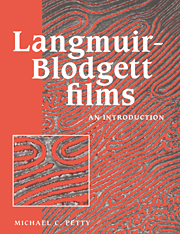7 - Optical properties
Published online by Cambridge University Press: 30 November 2009
Summary
Refractive index
The refractive index of materials is determined by the interaction of electromagnetic (EM) radiation with the molecules which they comprise (appendix B). This depends not only on the orientation of the electric field vector of the incident EM wave, but also on that of the electric dipoles produced in neighbouring molecules. Figure 7.1 shows an ideal arrangement of molecules in an LB monolayer. The sample coordinate system is (x, y, z) while that of the principal axes of the molecules is (x′, y′, z′). Careful measurements on fatty acid LB layers show that the films possess a biaxial symmetry with three independent permittivity values (Barnes and Sambles, 1987). However, two of the indices are very close in value and LB films are often approximated as uniaxial.
Several approaches can be used to measure the refractive indices of thin organic films (Petty, 1990). In some techniques, the film thickness is also obtained (section 5.8). The more popular methods, based on ellipsometry, surface plasmon resonance and waveguiding are discussed below. Figure 7.2 summarizes the results of such experiments by various workers using cadmium eicosanoate LB films (Swalen et al., 1978). It is evident that the refractive index for the extraordinary ray ne (p-polarization) is greater than that for the ordinary ray n∘ (s-polarization) by 0.04.
- Type
- Chapter
- Information
- Langmuir-Blodgett FilmsAn Introduction, pp. 167 - 196Publisher: Cambridge University PressPrint publication year: 1996



